Stunning footage reveals China’s secret new stealth bomber
Beijing has stunned the world with secret new combat aircraft spotted in Chinese skies in recent weeks. And they’ve left experts stumped.
Beijing has surprised the world with the appearance of a full set of secret new combat aircraft in Chinese skies in recent weeks.
Now, Western analysts are rushing to figure out what they are, what they can do – and when they can be expected to appear on the front lines.
“These apparent combat aircraft demonstrators are part of a larger PRC defence modernisation – the post-war era’s most dramatic,” notes Professor Andrew Erickson of the US Naval War College’s China Maritime Studies Institute (CMSI).
“The scope and scale of China’s military aviation advances evokes the Luftwaffe’s relentless rise amid Germany’s ramp-up for World War II.”
The mere presence of the fuzzy photos and footage on China’s heavily censored social media indicates high-level approval, although no official comment has been made by Politburo or People’s Liberation Army Air Force officials.
But analysts are generally confident of their authenticity.
Most appear to have been taken by people on the ground in and around the factories where the aircraft are being developed.
The reveal began with the official appearance of two new stealth aircraft at an air show in November. One was the long-suspected two-seat version of the Chengdu Aircraft Corporation’s J-20 “Mighty Dragon” interceptor fighter. The other was a Shenyang Aircraft Corporation J-35A, the land-based version of a smaller stealth fighter being developed for use on Chinese aircraft carriers.
But the first real surprises were saved for December 26 – the birthday of Communist China’s founder, Mao Zedong.
The Chengdu manufacturer deliberately flew previously unseen prototype combat aircraft over populated areas. Naturally, Chinese social media was awash with snapshots and video footage from excited observers below.

Now, it appears the final jewel in China’s future air force crown has also been revealed: The first glimpse of what may be the H-20 intercontinental stealth bomber began circulating this week.
“Today, no other nation is working simultaneously on so many distinct military aircraft programs in general, or so many modern tactical jet programs in particular, as China,” states Professor Erickson.
“In aviation and beyond, no other nation is pursuing so many major military megaprojects. “Welcome to the new PRC-led era of defence industrial warfare!”
Next Generation
“Anonymous Chinese internet commenters with better records for accuracy than others say that the new arrivals are part of an air warfare ‘tea set’ and that we have not yet seen the ‘teapot’ – the long-expected H-20 stealth bomber,” analyst Bill Sweetman wrote for the Australian Strategic Policy Institute (ASPI) shortly before the footage of the suspected H-20 appeared.
Very little about the new Chinese combat aircraft suite is known beyond that which can be gleaned from their photos.
International aviation analysts have dubbed the mid-sized stealth aircraft the Chengdu J-36 and the smaller the Shenyang J-50. This is based on the serial numbering format stencilled on their airframes and the manufacturer of the “chase planes” flown alongside them.
Both share a distorted diamond-shaped, tailless airframe. This means they must rely on engine thrust and a multitude of flaps to steer. But the sacrifice of a traditional tailplane produces a significantly reduced radar cross-section.
The aircraft believed to potentially be the H-20 stealth bomber was flying higher, and its fighter “chase plane” was not in close company. This makes the limited footage harder to analyse and verify.
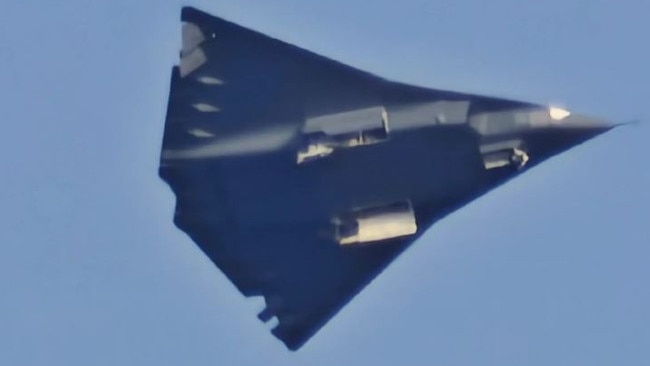
But it is clearly not a flying wing, as are its United States Air Force B-2 “Spirit” and B-21 “Raider” equivalents. And while it is roughly diamond-shaped like its smaller siblings, it has separate lengthy wings, a broad central fuselage and a prominent stabilising surface at the tail section.
“I’ve been watching China modernise their military for quite a while,” outgoing Secretary of the US Air Force Frank Kendall told Air and Space Forces this week.
“They’re working aggressively to build a military designed to keep the US out of the Western Pacific, and I think, over time, they have more ambitions than even that.”
A recent Pentagon report states China’s military aviation forces amount to some 3150 aircraft (not counting uncrewed aircraft). About 2400 of these are fighter, bomber, multi-mission and attack aircraft. About 1300 are regarded as modern “fourth generation” fighters.
Many analysts consider the USAAF F-22 “Raptor” and F-35 “Lightning II” to be the only existing “fifth generation” aircraft – although some contend China’s J-20 fits the bill.
But the terminology is more a marketing ploy than a real designation.
“What Lockheed Martin would call 5-gen fighters combine supersonic speed and manoeuvrability with some degree of stealth. The Chengdu J-20 fighter is fifth-generation by that standard,” writes Sweetman.
And the yardsticks by which combat aircraft are measured are rapidly changing.
“The speed, agility, range and stealth of an individual aircraft type are still important, but they’re no longer the whole story of air combat,” Sweetman adds.
“Advances in sensing, processing and communications are changing military operations.”
H-20 Strategic Bomber
The appearance of a Chinese stealth bomber to rival the USAAF’s famous B-2 “Spirit” has been long anticipated. And if the single piece of footage circulating on Chinese social media is real, it’s now a flying reality.
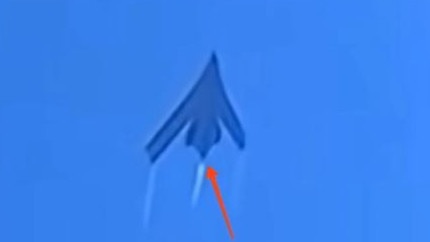
That’s despite a new Pentagon assessment which, in December, declared it was expected to “debut sometime in the next decade”. That may mean entering active service – if the single piece of footage shows the real thing.
The previously unseen large aircraft is seen flying in the same frame as a Shenyang J-16 “Hidden Dragon” strike fighter. But the aircraft are not close together, making it challenging to infer comparative size and scale.
Previous Chinese statements give the H-20 an operational range of 16,000km – enough to fly from Beijing to Sydney and back. This will allow the bomber to strike targets across what it calls the “Second Island Chain” (delineated by Japan, Guam, and Papua New Guinea) area of Chinese military influence.
The H-20 is China's new-generation stealth strategic bomber. Chinese people, especially military enthusiasts, have been eagerly looking forward to it, and it seems to be on the verge of being unveiled.
— é›è¿‡ç•™å£° (@szygls) January 7, 2025
è½°20是ä¸å›½æ–°ä¸€ä»£éšå½¢æˆ˜ç•¥è½°ç‚¸æœºã€‚ä¸å›½äººç‰¹åˆ«æ˜¯å†›è¿·ç¿˜é¦–以盼,已呼之欲出。 pic.twitter.com/vvDgMlSiZh
The Pentagon assessment says the bomber could “cover the globe” with air-to-air and ground refuelling support. This capability was recently demonstrated with US B-2 bombers operating out of Australia and the island of Diego Garcia to strike targets in the Middle East.
“It is expected to employ conventional and nuclear weaponry and feature a stealthy design,” the Pentagon report adds.
But stealth is only part of a “fifth” or “sixth” generation combat aircraft design.
What isn’t known is the quality of the engines, sensors, computers and communications it will carry.
The US is in the process of testing its own next-generation bomber, the Northrop Grumman B-21. It is a fast-track design intended to turn the immensely complex B-2 concept into an affordable, mass-produced airframe.
The US has just 19 of the handcrafted B-2 bombers available. These entered service in 1997 and are reportedly undergoing life-extension upgrades.
J-36 Interdictor?
The big Chinese combat aircraft that was first seen on December 26 came as something of a surprise to aviation analysts.
What is it for? What does it do?
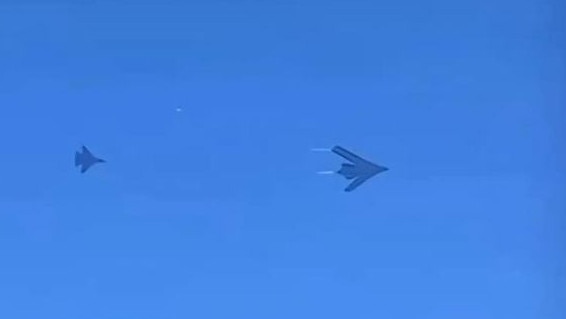
“This unprecedented diamond-shaped tailless design, with unique intake layout and angled trailing edge intersecting its thrust nozzles, eliminates a major radar signature source across bands and aspects,” writes Professor Erikson.
“Capacious fuselage offers significant internal space for fuel and weapons, implying a high-altitude, high-endurance tactical combat platform.”
But is it a strike fighter? A heavy fighter? Or both?
“The term “fighter” might well become anachronistic, as the next generation could be better described as “high performance, weaponised command platforms”,” aviation analyst Rick Joe writes for The Diplomat.
“Thus, perhaps a generic term such as ‘combat aircraft’ may be appropriate. Some have even suggested the J-36 is the equivalent of an ‘aerial destroyer’ or ‘aerial cruiser’ in terms of its capability for command, networking, persistence, and weapons capacity in context of the contemporary aerial warfare landscape, though a direct naval analogy introduces misunderstandings as well.”
— Justin Bronk (@Justin_Br0nk) December 26, 2024
The new stealth aircraft has been dubbed J-36 based on the Chinese designation conventions used in the serial number stencilled on its side. It flew in company with a two-seat J-20S chase plane, indicating its developer was Chengdu Aircraft Corporation.
What is also obvious is that great range, endurance and payload will enable the huge J-36 to interdict any combat aircraft or warship long before they reach the “First Island Chain” – including Taiwan and the Philippines.
It would use its stealthiness to guide (and deploy) missiles and drones to its targets.
Based on comparisons to the chase plane flying alongside it, the tailless flying double-delta wing J-36 appears to be about 22 meters long with a wingspan of about 20m. Its broad fuselage contains a cockpit, potentially large enough for two pilots to sit beside each other.
“The aircraft is powered by a unique three-engine configuration, presumably fed by one intake each, and imagery thus far seems to indicate a low observable exhaust design,” adds Joe.
Its three engines are likely to give the J-36 “supercruise” capability – that of flying faster than the speed of sound without the need for a fuel-guzzling afterburner.
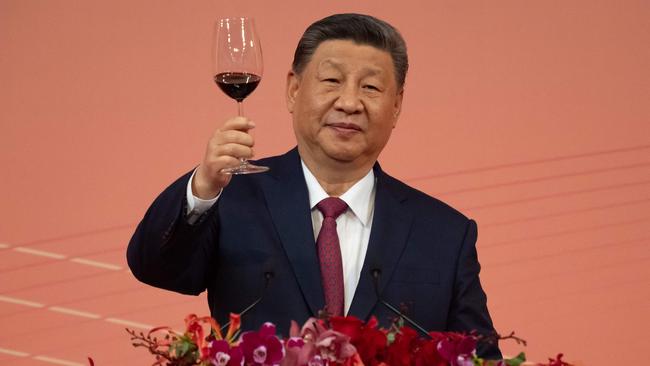
“Speed on one side of a conflict is an important advantage,” Sweetman explains.
“If the J-36 can penetrate to threaten bases in the second island chain, forcing the US to move B-21s, B-52s and other high-value assets further back, US strike sortie rate and effectiveness will diminish.”
Fighter, bomber, remote control centre: The J-36 has analysts thinking.
“There are other puzzles about the design: apparently large electro-optical sensor windows on either side of the nose, and a dark-tinted canopy that wouldn’t be road-legal in many US states,” Sweetman adds.
But the nose “windows” could also indicate a new weapon.
“If you wanted to integrate a high-energy antimissile laser into an aircraft, with a hemisphere-plus field of fire but without unstealthy turrets, it might from the outside look like those transparencies … Cue panic.”
J-50 Warrior?
The smaller stealth aircraft unveiled on December 26 brings it back into the realm of existing aircraft. But not its overall appearance and design.
The presence of a J-16 “Flanker” fighter as its chase plane implies the delta wing fighter was built by Shenyang Aircraft Corporation. And the close proximity of this aircraft adds to the insight revealed by the imagery of the new design.
— OedoSoldier (@OedoSoldier) December 26, 2024
“The second airframe is a smaller twin-engine, sharply-swept wing lacking a vertical stabiliser,” writes Joe.
It also has distinctive triangular-shaped trailing-edge extensions that project beyond the engine exhausts.
What isn’t observable in the available imagery is whether or not the aircraft has a cockpit.
That leaves the potential open for the new design to be a “loyal wingman” style autonomous drone. These are being developed worldwide to operate in concert with crewed aircraft on dangerous missions.
第三圈 pic.twitter.com/GvKReHJ3sm
— æ±é¢¨ (@eastwind6699) December 26, 2024
“China’s two strikingly-configured new airframes have manifold features associated with the latest cohort of low-observable aircraft, including radar absorbing material and inlets and outlets positioned and shaped to minimise radar deflection,” adds Joe.
“Tailessness mirrors international state-of-the-art efforts, including the Northrop Grumman B-2’s split rudders and B-21’s sleek flying wing configuration.”
Analysts imply that the tentatively-dubbed J-50 is capable of high speeds and extended range – based on the lack of drag produced by a vertical surface.
Its large internal volume also suggests the ability to carry considerable loads of fuel and weapons, both of which would suit operations over the vast distances of the Pacific and Indian Oceans.
US Indecision
“China’s two new combat aircraft demonstrators are best understood not as portending invincible stealthiness but rather as defence industrial capability indicators and potentially potent weapons platforms, particularly for missiles of long and increasing range,” argues Professor Erikson.
We don’t know what the US next-generation aircraft design studies look like. That’s despite rumoured test flights of prototypes as early as 2020.
What we do know is that work has been suspended on their development because they have been deemed too expensive.
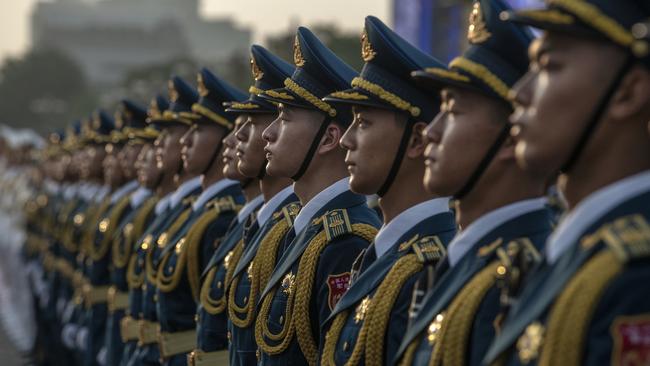
The long-range, air-to-air combat-focused Next-Generation Air Dominance (NGAD) was trending to cost as much as two or three F-35 fighters each. And the 10-year-old F-35, which remains limited to “Initial Operational Capability (IOC)” because many of its advertised advanced features remain non-functional, is already the world’s most expensive defence project.
Now, the Pentagon hopes the F-35 will be sufficiently capable to lead flights of new Collaborative Combat Aircraft (CCA – or “Loyal Wingman” drones) until it can come up with a new idea.
Meanwhile, European nations and Japan are collaborating on designing and constructing next-generation combat aircraft called the Future Combat Air System and Tempest.
But the unclassified version of the US Pentagon’s latest annual report to Congress on Chinese military advances does not mention the existence of the new fighter designs that appeared in recent weeks.
“My operators were not 100 per cent sure they had the right aeroplane,” USAF Secretary Kendall said.
“And I agree with that. I think it’s really worthwhile to think carefully about what is essentially an F-22 replacement. Is that really the right new design?
“We’re not going to get another sixth-generation program any time soon.
“This is a tens of billions of dollars commitment, and it’s a multidecade commitment, so you really want to be sure you’re pursuing the best operational capability with those resources.”
But the strategic pressure continues to mount.
Admiral John Aquilino, the outgoing commander for US forces in the Indo-Pacific region, said in March that the PLAAF was “soon to be the world’s largest Air Force”.

“In the three years since I took command, the PLA has added over 400 fighter aircraft (almost all 4th and 5th generation variants)…” Aquilino said.
“PLA aviation has also undergone a significant transformation since 2021.”
But the value of many of those aircraft is suspect.
Analyst Rick Joe argues in The Diplomat that the era of dogfights – and even within visual range engagements – is coming to a rapid end.
“I would humbly argue that the future of air superiority will emphasise stealthy, persistent manned platforms equipped with sufficient power generation, networking, and sensors to network with and command increasingly sophisticated and autonomous UCAVs alongside existing manned tactical aircraft,” he said.
And the US – and China – aren’t there yet.
“The emergence of the J-36 merely reflects the emergence of genuine competition,” he concludes.
Jamie Seidel is a freelance writer | @jamieseidel.bsky.social
Originally published as Stunning footage reveals China’s secret new stealth bomber





